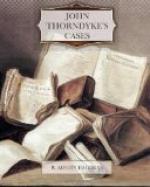He handed me a note which had been left, with the empty suit-case, by a messenger, shortly before, and I was about to read it when an agitated knock was heard at our door. The visitor, whom I admitted, was a rather haggard and dishevelled elderly gentleman, who, as he entered, peered inquisitively through his concave spectacles from one of us to the other.
“Allow me to introduce myself, gentlemen,” said he. “I am Professor Poppelbaum.”
Thorndyke bowed and offered a chair.
“I called yesterday afternoon,” our visitor continued, “at Scotland Yard, where I heard of your remarkable decipherment and of the convincing proof of its correctness. Thereupon I borrowed the cryptogram, and have spent the entire night in studying it, but I cannot connect your solution with any of the characters. I wonder if you would do me the great favour of enlightening me as to your method of decipherment, and so save me further sleepless nights? You may rely on my discretion.”
“Have you the document with you?” asked Thorndyke.
The Professor produced it from his pocket-book, and passed it to my colleague.
“You observe, Professor,” said the latter, “that this is a laid paper, and has no water-mark?”
“Yes, I noticed that.”
“And that the writing is in indelible Chinese ink?”
“Yes, yes,” said the savant impatiently; “but it is the inscription that interests me, not the paper and ink.”
“Precisely,” said Thorndyke. “Now, it was the ink that interested me when I caught a glimpse of the document three days ago. ‘Why,’ I asked myself, ’should anyone use this troublesome medium’—for this appears to be stick ink—’when good writing ink is to be had?’ What advantages has Chinese ink over writing ink? It has several advantages as a drawing ink, but for writing purposes it has only one: it is quite unaffected by wet. The obvious inference, then, was that this document was, for some reason, likely to be exposed to wet. But this inference instantly suggested another, which I was yesterday able to put to the test—thus.”
He filled a tumbler with water, and, rolling up the document, dropped it in. Immediately there began to appear on it a new set of characters of a curious grey colour. In a few seconds Thorndyke lifted out the wet paper, and held it up to the light, and now there was plainly visible an inscription in transparent lettering, like a very distinct water-mark. It was in printed Roman capitals, written across the other writing, and read:
“THE PICKERDILLEY STUF IS UP THE CHIMBLY 416 WARDOUR ST 2ND FLOUR BACK IT WAS HID BECOS OF OLD MOAKEYS JOOD MOAKEY IS A BLITER.”
The Professor regarded the inscription with profound disfavour.
“How do you suppose this was done?” he asked gloomily.
“I will show you,” said Thorndyke. “I have prepared a piece of paper to demonstrate the process to Dr. Jervis. It is exceedingly simple.”




